Archives
Reuter Monitor: The big bet
Thursday 20 August 2015
The Reuter Monitor system was conceived in 1972 after the “Nixon shock” of the previous year ended the ability to convert the US dollar into a fixed amount of gold. This signalled the formal end of the Bretton Woods system of static currency exchange rates. Currencies could now move freely against one another and a new, unregulated market emerged.
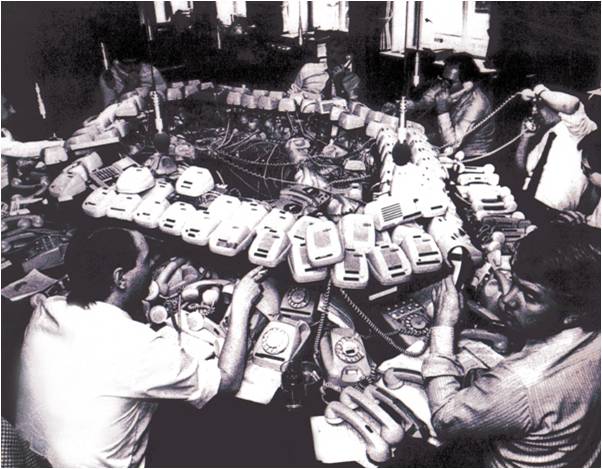 Reuters was profiting handsomely from a joint venture with Ultronic Systems to develop and distribute a stock exchange quotes system, without having to risk capital. This system was variously known as Stockmaster, Videomaster, SGS, QRS or just plain Quotes. Reuters had constructed data centres, an engineering development and support organisation, and a sales force with close contacts in banks, brokerages and telecommunications authorities.
Reuters was profiting handsomely from a joint venture with Ultronic Systems to develop and distribute a stock exchange quotes system, without having to risk capital. This system was variously known as Stockmaster, Videomaster, SGS, QRS or just plain Quotes. Reuters had constructed data centres, an engineering development and support organisation, and a sales force with close contacts in banks, brokerages and telecommunications authorities.
Traditional competitors, including a consortium of banks, were rumoured to be addressing the same opportunity.
PHOTO: A dealing room before the age of the Reuter Monitor
The idea of developing an international "forex network" to capitalise on this situation was risky.
The market would have to be built from scratch and take account of competitiveness between market players. It challenged the position of existing participants like money brokers.
It needed capital for computers, client equipment, software and hardware development. A considerable bank loan was required and this was a first for Reuters.
It assumed that some customers would pay for the privilege of advertising their precious buy and sell rates for different currencies, while others would pay to see those rates.
It appeared to run against telecommunications rules about carrying traffic from a third party on a leased line.
It required the development of reliable, efficient software. Reuters expertise had been mainly in hardware.
it played to Reuters strengths in terms of the innovative use of communications and its principles of accuracy, speed and integrity
However, it played to Reuters strengths in terms of the innovative use of communications and its principles of accuracy, speed and integrity. Before embarking on the project, Reuters held an extensive set of demonstrations with potential clients using a hardware product emulation, based on the existing Quotes system. Hence the four-character Stockmaster code led inadvertently to the four-character page name for financial instruments on Monitor. Subsequently, page names like BOND became valuable resources, like memorable car number plates or Twitter handles.
The equipment for sales presentations held beyond head office was necessarily primitive, consisting of a screen, a keyboard and a tape recorder to simulate the arrival of data from the host. The presenter would type in a page name and, on cue, the presenter's assistant would operate the tape recorder to display the page. Famously, one discussion went awry when the concealed assistant fell asleep on the job.
The technical context was interesting. Apple and Microsoft had not been founded. Newly created Intel had just launched its first 4-bit microprocessor. Design of the Internet, as we know it, had not started. There was no suitable operating system or high level computer language on which to base the development. The Google founders had not been born.
Sensibly, Reuters contracted an experienced software house, Scicon, to develop the software. Pentagram and (later Sir) Kenneth Grange designed the client terminal. Reuters staff developed the technical environment and the client equipment, including the problem of fitting the keyboard electronics into the elegantly designed housing.
The technical design, to some extent, mirrored the proven Stockmaster system, with a network of interconnected host computers, each with a database of information serving clients in one geographic region. Each host connected to three others in the network plus an up-to-date standby machine, ready to take over automatically in the event of an equipment failure.
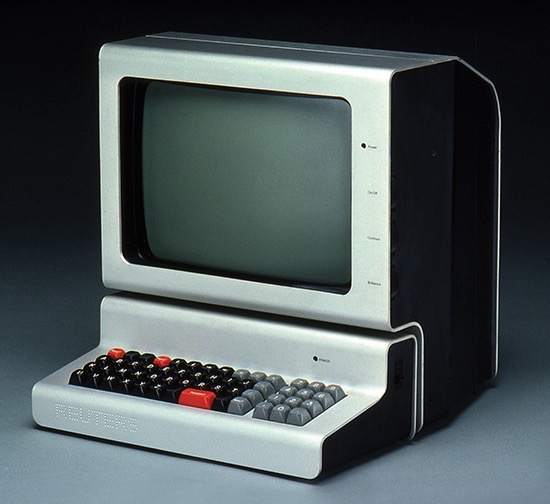 The screen and keyboard on the client's desk was connected to the host computer via a terminal controller and an analogue 1200bps telephone line. Several terminal controllers shared the same host connection. A system of polling was used to control which device could send data. The terminal controller was a general purpose PDP8 mini-computer containing the logic to control three screens and keyboards. The initial PDP8 contained up to 20 printed circuit boards, so that transporting the controller to the first client offices, by London taxi, was a stressful affair.
The screen and keyboard on the client's desk was connected to the host computer via a terminal controller and an analogue 1200bps telephone line. Several terminal controllers shared the same host connection. A system of polling was used to control which device could send data. The terminal controller was a general purpose PDP8 mini-computer containing the logic to control three screens and keyboards. The initial PDP8 contained up to 20 printed circuit boards, so that transporting the controller to the first client offices, by London taxi, was a stressful affair.
One of the big technical challenges was to produce a terminal controller that could operate non-stop in an office environment, including the occasional intervention by the office cleaner. Reuters engineering staff customised each terminal controller, including a specialised front-panel and an options card. The options card provided a number of value-added hardware features including remote reboot and audible alarms.
PHOTO: The Reuter Monitor keystation in its brushed aluminium finish
The first screen and keyboard, or keystation, was striking, with a brushed aluminium finish, later used in the iPhone, and an A-Z rather than QWERTY keyboard layout (everyone knew that traders could not type). The first batch of screens had notoriously sharp edges, which drew blood and had to be filed down by field service staff. The first Apple Macintosh in 1984 had a remarkably similar profile.
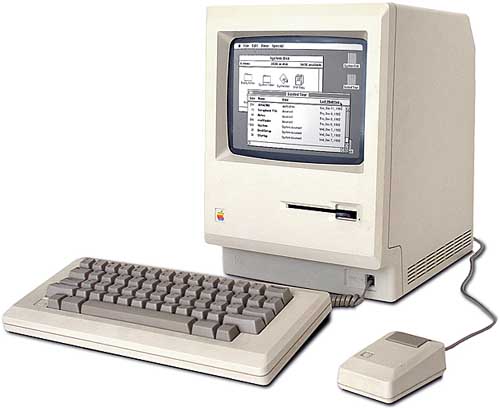 PHOTO: The Apple Macintosh computer had a remarkably similar profile to the Reuter Monitor keystation
PHOTO: The Apple Macintosh computer had a remarkably similar profile to the Reuter Monitor keystation
The idea was simple. The contributor owned one or more displayable pages of information, each identified by a four character mnemonic code, for example BAXX for Barclays exchange rates. Each page consisted of 12 rows of 64 upper case characters. The body of the page was laid out, as the contributor wished, in a tabular fashion rather like a spreadsheet. The display also included an alert area which was used to inform affected users of a significant change, e.g. a news alert.
To update a field of the page, the contributor specified the page row (A-M) followed by the column (J-Z) and the data to be displayed. Hence the A-Z keyboard. The contributor could specify to Reuters those competitor organisations who should not be allowed to view his information.
There was also the concept of a multi-contributor page which could be updated by multiple organisations or international branches of the same firm. These pages were used to provide comparative displays and introduce a competitive edge.
When a field of a page was updated, the change would be distributed and highlighted on any terminal in the world displaying that page. The first terminal controller software was downloaded from the host. Several versions were maintained and this is how the terminal software was distributed and updated. These features, though now common, gave the product an innovative feel.
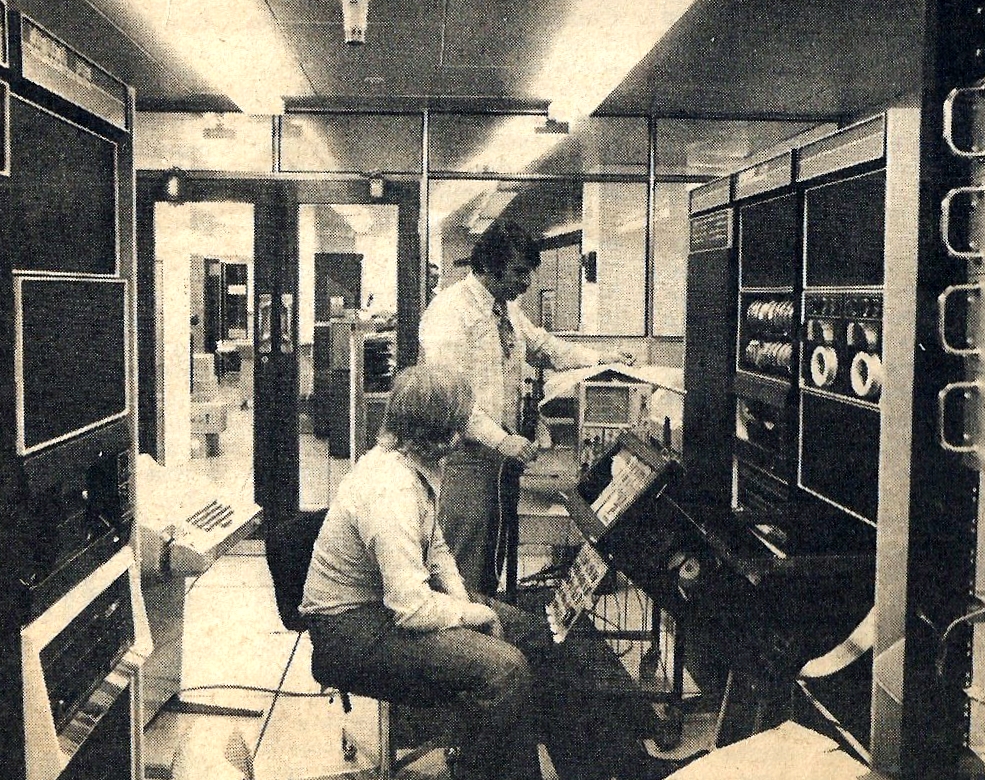 The design was at the limit of technical feasibility. A current smart phone has more than 10,000 times the resources of the first PDP11/20 host computer in terms of processing power, memory, storage and communications. However Reuters was resourceful in developing a communications multiplexor to interface many communications lines, and in adopting static rather than rotating memory for fast page access.
The design was at the limit of technical feasibility. A current smart phone has more than 10,000 times the resources of the first PDP11/20 host computer in terms of processing power, memory, storage and communications. However Reuters was resourceful in developing a communications multiplexor to interface many communications lines, and in adopting static rather than rotating memory for fast page access.
PHOTO: Engineers in action at 85 Fleet Street, 1973
This is a rather grand term for a neglected area. Perhaps because of doubts about success of the service, the facilities provided were simple, and mainly stayed that way. Each page belonged to a service, which a client could pay for. In addition a contributor could say "bank XYZ cannot see my information". This would apply to some or all of the contributor's pages and all bank XYZ keystations, wherever located, now and in the future. This required an external record keeping system and coordination between file maintenance groups around the world. The human interface to the Monitor host was a length of paper tape. Reuters management didn't ask questions and hoped that all would be well.
PHOTO: The London file maintenance group in 1981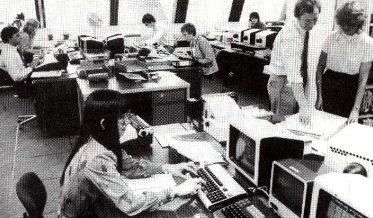
The initial development environment was primitive, involving paper tape, small spools of magnetic tape and data entry via teletype, in a noisy air-conditioned computer room.
The development of PDP8 software was particularly challenging. Only 1,000 12-bit words of memory were available for the software. The computer had just eight instructions and two addressable registers. The exotic system of memory pages meant that the software had to be squeezed into memory, like solving a jigsaw puzzle. Fortunately Reuters employed a development wizard who went away for the weekend and returned with a working solution.
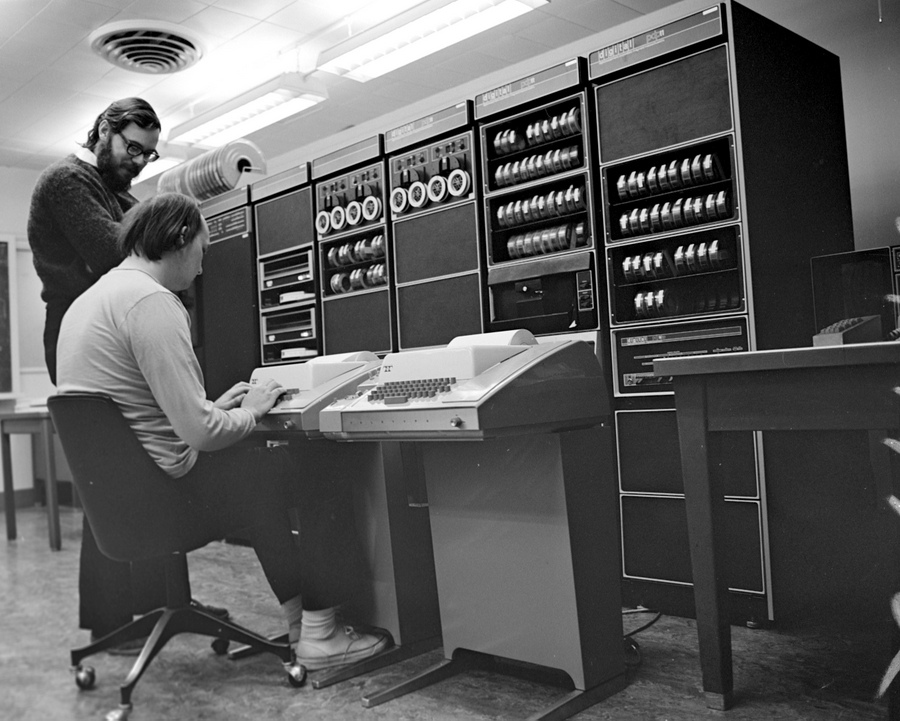 There was a system of "software acceptance testing". This took place on parts of the live network at around 9:00 pm in London, after New York had closed for business and assuming that the US West Coast and East Asia were quiet. The only means of taking a security copy of the Monitor database was to dump it to paper tape - a lengthy process. A group of grumpy executives, engineers and developers would gather to follow a script and generally try to break the system. The process seemed to work.
There was a system of "software acceptance testing". This took place on parts of the live network at around 9:00 pm in London, after New York had closed for business and assuming that the US West Coast and East Asia were quiet. The only means of taking a security copy of the Monitor database was to dump it to paper tape - a lengthy process. A group of grumpy executives, engineers and developers would gather to follow a script and generally try to break the system. The process seemed to work.
PHOTO: Dennis Ritchie and Ken Thompson, inventors of the Unix operating system, using a PDP-11 minicomputer
Putting things back to normal was an equally tedious business, extending into the early hours. Normally a visit was necessary to Mick's Café in Fleet Street, which never seemed to close.
The Monitor service first ran in London on 25 June 1973 with approximately 30 clients. During the next year inter-connected host machines were added in New York, Frankfurt and Zurich and initial concerns about change, reliability and privacy were dispelled. Market acceptance led to delays in the supply of client equipment and telephone lines. Success later led to a problem with the capital value of Reuters-owned client equipment. This was resolved through leasing arrangements.
From the beginning clients were wary of spending their time updating Monitor. A creative hardware solution involving the copying of the keyboard input destined for their in-house systems helped to address this objection for some clients. Reuters sales staff used a range of techniques to encourage contributors to keep their rates up to date and give the service momentum.
The Monitor design was so simple that it could store any kind of data within the limits of the page size. Contributors for government bonds data, commodities, equities and US government securities extended Monitor coverage. Pages were later used to store compressed, binary data for interpretation by client site machines.
A money news feed was added in 1975. Initially the constraints on the size of a news alert message, news headline and text page caused some concern amongst editorial staff as inevitably technology influenced the way people worked.
In the same year, a system of "dynamic inhibits" was introduced. This allowed the page owner to change dynamically those who could see a page, and alert them to the fact. This was used to good effect by the Reserve Bank of Australia, for example, to release embargoed announcements. The first automated contributions were from Mocatta Metals, thanks to software from a Reuters staffer. Initially Mocatta could insert data faster than host communications to America would permit, with predictable results.
In 1975 Reuters became an early user of satellite communications, from London to Hong Kong. The long round-trip delay on these connections required the development of a protocol with many unacknowledged messages in flight - a relatively new concept. As part of a second news project, in 1977, a "Monitor device driver" was built for a PDP11 operating system, RSX11M. This became a standard way for external systems to connect to Monitor.
In the United States, Monitor fed the Central Communicator computer and Rowgrabber, a frame-based broadcast system. In the UK and France there were indirect connections to videotext systems Prestel and Minitel for some data.
Success led to requests from clients to integrate Monitor with their own computer systems and trading rooms. This also formed a lucrative source of revenue, with the added benefit of tying clients ever closer to Reuters. These interface products included
- Data feeds: the ability to retrieve and contribute data from client terminals and computers.
- Video switches: determining where a particular video output is displayed.
- Keyboard switches: the ability, by command, to direct the output from a keyboard to one of a number of screens.
- Programmable keyboards: customisable keyboards that could communicate with different systems, thus saving valuable desk space.
- Page broadcast systems: which displayed a cycle of Monitor pages on video screens in the trading room.
Much later, interfaces were developed for networked trading room systems like Triarch and Teknekron.
A family of terminal controller devices was implemented over time, supporting more keystations and interfacing to both Monitor, Quotes and client computers. The most successful of these, which generated large profits, was the MES300. Based on an in-house microprocessor design, the device was cheaper, smaller and more reliable than its predecessors, supporting five keystations. Around 30,000 were deployed. Before that time Reuters used more than 20 per cent of the total PDP8 production run of some 50,000 computers.
At the end of the decade, concentrators were placed in front of the host to handle client communications, allowing each host to support around 1,500 terminal controllers. The Dealing conversations concentrator connected in the same way.
1981 was the formal start of the microcomputer revolution with the introduction of the IBM PC, and the BBC Micro in the UK. Whereas the IBM PC was targeted at business users, the cheaper BBC micro was part of a computer literacy project for young and old (the makers Acorn/ARM went on to great things, especially with Apple).
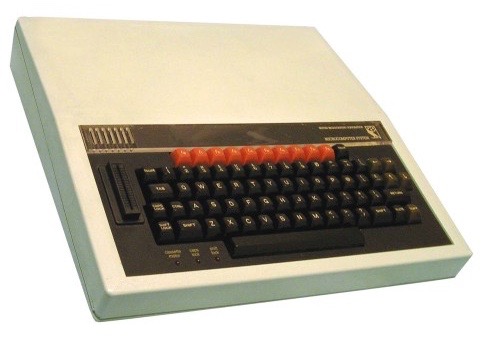 Reuters used the BBC Micro as an inexpensive but powerful extension for the Monitor terminal controller. A range of applications was developed by Richards Computer Products, including the charting of historical time series. Later Reuters designed its own single board implementation of the BBC Micro.
Reuters used the BBC Micro as an inexpensive but powerful extension for the Monitor terminal controller. A range of applications was developed by Richards Computer Products, including the charting of historical time series. Later Reuters designed its own single board implementation of the BBC Micro.
PHOTO: BBC Micro computer
The host computer did not have enough power to satisfy the need for the additional applications required by clients. Instead it came to act as a hub for a multitude of computers which read, processed and updated Monitor pages. The most important was the Monitor Manipulation Processor (MMP) which had relatively high speed access to the Monitor network and generated many value-added pages for display and for interpretation by other machines at the client site. For example, USFX was a page, maintained by Reuters, which showed the most competitive rates from American contributors.
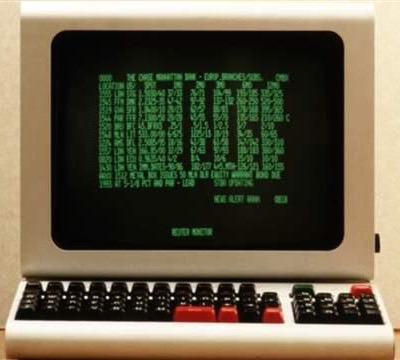 In 1981, Reuter Monitor Dealing was launched (about which more elsewhere). This combined access to Monitor data with conversational dealing, rather like intelligent instant messaging between traders. Here Monitor was used as a reliable brand to introduce a completely new service.
In 1981, Reuter Monitor Dealing was launched (about which more elsewhere). This combined access to Monitor data with conversational dealing, rather like intelligent instant messaging between traders. Here Monitor was used as a reliable brand to introduce a completely new service.
PHOTO: Reuter Monitor Dealing terminal, 1981
Further markets were investigated. For example, Monitor Shipping and its associated news service addressed the need to match oil and dry cargo tanker owners with those wishing to transport goods. Clients could use an alert mechanism to announce significant changes to selected users.
One of the final steps in the expansion of the Monitor network was referred to as Monitor Dualling in 1984. This was a huge implementation exercise which effectively spread the work of a single Monitor host over two sets of computers and communications lines, providing a doubling of storage, retrieval and update capacity.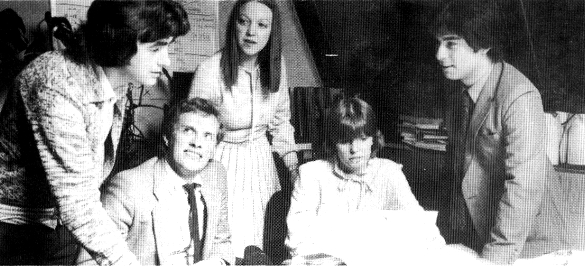
PHOTO: Developers Paul McNamara, Peter Kingslake, Pam Pemberton, Jan Atkins and Paul Tate, 1981
By the end of the decade Monitor pages were held on the IDN network, as it became the best way of distributing information. Many clients contributed data directly from their own computers via a Reuters interface device.
The host computer software, written in machine code, was migrated to the most powerful PDP-11 model available. However it could not be moved to a different hardware architecture, even from the same manufacturer, without complete redevelopment, which no-one could contemplate. It retained its 16-bit computer heritage. Rather like an old MS-DOS personal computer, some software elements, especially storage for messages in transit, had to reside in the first 32K bytes of memory, and this became a problem.
More fundamentally, each host could only pass on page updates to three other directly-connected hosts (though it could accept updates from many machines). The network grew like a tree with multiple branches, rather than a star, for efficiency. In the final network, a single page update might need to pass through 10 or more machines in order to reach the furthest database copy.
Implementing new host features became problematic with so many copies to maintain. However it was good news for developers who became extremely well-travelled, and were always welcomed on British Airways.
The longevity of Monitor meant that in the 1980s Reuters was still developing in machine code rather than in a high level language like C. This had the perverse advantage that some software issues could be resolved by sending a patch, a small modification to the binary code, rather than a new software release. Each full software release anticipated the need for software patches and set aside memory to accommodate them.
Some in-house improvements were made. Reliance on paper tape for file maintenance operations was removed. Development was enhanced, using modern terminals and powerful time-sharing systems, which produced host software that could be installed quickly, from floppy disk rather than paper tape.
The Monitor service was formally turned off in 1999. At its peak the network consisted of 72 live/standby pairs of host computers in 11 data centres serving approximately 100,000 directly connected workstations, with terminals located in almost every country with an active economy.
At the closedown party, everyone was presented with a personalised wooden plaque showing the extent of the network. As far as we know, none of these was reduced to ashes to commemorate the death of a once great servant.
PHOTO: Personalised wooden plaque presented at the Reuter Monitor closedown party in 1999
Simple ideas can be valuable and adaptable. Twitter is an example.
It is wise to design for as large a network as possible, in terms of technical resources like addresses and external interfaces. For example, Internet Protocol version 4 addresses were close to exhaustion by 2008. Marketing estimates should be ignored.
It is worthwhile patenting the key ideas that underlie a product, if only to be used in defence against an aggressor. This might have deterred a similar service from Telerate/Cantor Fitzgerald.
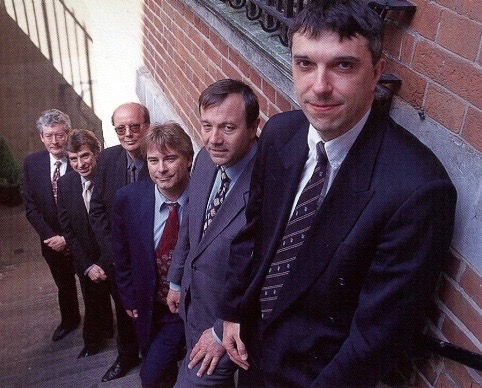 PHOTO: UK developers John Adams, Trevor Bartlett, Dick Cleaver, Paul Tate, Paul Gibbons and Chris Aries wait for The City Golf Club to open, in order to drown their sorrows at the closedown of the Reuter Monitor in 1999
PHOTO: UK developers John Adams, Trevor Bartlett, Dick Cleaver, Paul Tate, Paul Gibbons and Chris Aries wait for The City Golf Club to open, in order to drown their sorrows at the closedown of the Reuter Monitor in 1999
Following are some of the people from Reuters head office who deserve a mention for their contribution to Monitor. This list excludes sales and operations staff world-wide who made the product a success. I apologise if your name has been omitted and you think it should appear:
David Russell, Fred Taylor, John Ransom, André Villeneuve, Peter Howse, David Manns, Maurice Fletcher, John Adams, Mike Cornish, Tony Cornish, Barry Barnett, Dredge Liversedge, Herbie Gross, Werner Van Zoggel, Patrick Mannix, Phil Arnett, Mike Gharibian, Colin Linford, Gill Hibbs, Trevor Bartlett, Tom Grainger, Mike Griffin, Paul Tate, Dick Cleaver, Paul Gibbons, Pam Pemberton, Alan Girvin, Alan Fazakerley, Mike Green, Larry Jones, Mark Daley, Clive Underhill, John Richards, Jan Atkins, Peter Kingslake, Howard Rice-Smith, Ken Pratt, Paul Gough, Ken Middleton, Derek Gardiner, Charlie Blackburn, Maggie Stone, Jane Biltoo.
■
- « Previous
- Next »
- 11 of 18

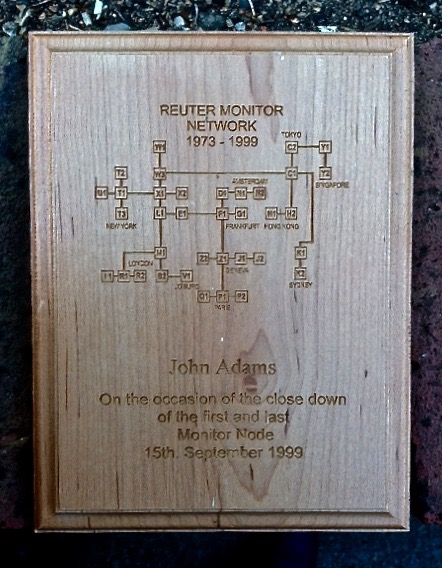 EPILOGUE
EPILOGUE